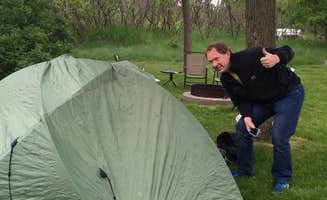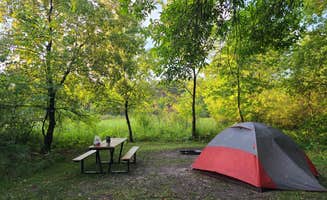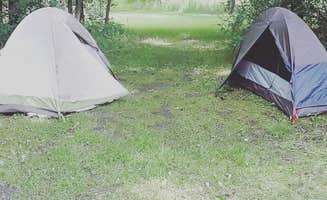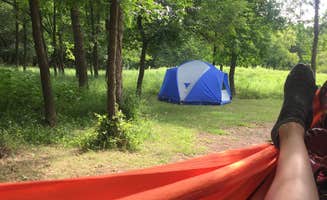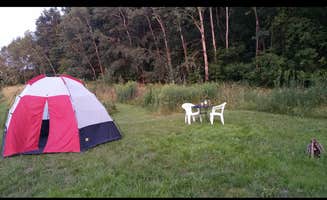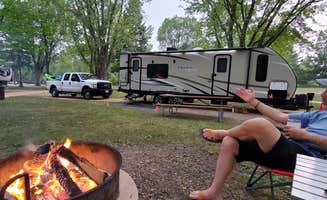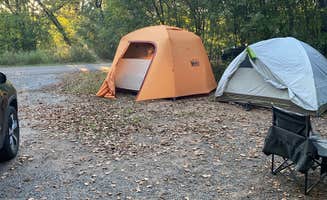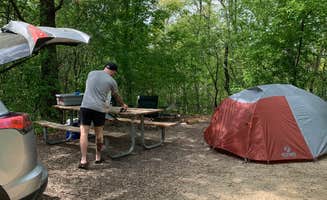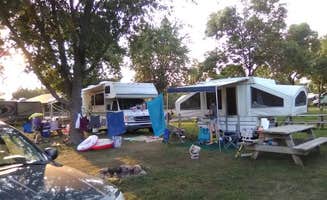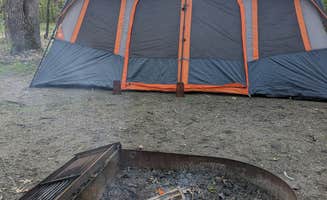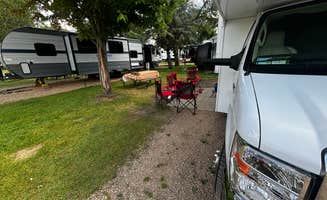Camping near North St. Paul, Minnesota offers diverse terrain from prairie settings to riverfront locations within a 45-minute drive radius. The region receives approximately 32 inches of annual rainfall, creating lush summer landscapes but also contributing to seasonal mosquito activity from June through August. Most campgrounds in this area sit between 700-950 feet elevation, providing relatively flat terrain suitable for campers of all experience levels.
What to do
Hiking varied terrain: At Afton State Park Campground, trails accommodate different skill levels across multiple landscapes. "The hike to the campground is short and grueling. A few of the sites are in wooded areas, but we stayed in one of the prairie sites. The terrain is just hilly enough - and in August - the grass long enough to give the sites a sense of privacy and seclusion," notes Andrew C.
Kayaking and water activities: Water-based recreation provides summer relief at multiple parks. "They have a home made lake that has a sand bottom but it has chlorine like a pool so no weeds. Great for swimming," reports Timothy S. about Lake Elmo County Park Reserve. At Lebanon Hills Regional Park, one visitor highlighted: "Nice little lake to kayak on."
Trail exploration: Bunker Hills Regional Park offers extensive trail networks for day hiking. "For being in the middle of the northern suburbs of Minneapolis, this park and campground is surprisingly woodsy, secluded and spacious," explains Doug B. Another visitor adds that despite nearby amenities, "the actual campsite, bike/walking/horse trails make you forget all of that."
What campers like
Site privacy levels: Lebanon Hills Regional Park offers varying degrees of seclusion. "We live about 15 mins. away from this campground. We stayed in the East Loop which is for smaller RVs and tents. Our spot was spacious, and close to the bathrooms and play area," shares Angela L. Sites with full hookups tend to be more open, while electric-only sites are "more tucked away in the pines."
Filtered swimming areas: Lake Elmo's swimming facilities stand out among regional options. "They have a home made lake that has a sand bottom but it has chlorine like a pool so no weeds. Great for swimming," notes Timothy S. This provides a unique alternative to natural swimming areas.
Walk-in site options: Rice Creek Campgrounds offers tent-only loops with walk-in sites. "I loved the look of the 'TENT ONLY' loop - you don't see this often... And the fact that this loop (F LOOP) was 'tent only' meant no generators! It was very quiet!" reports Amy G., who appreciated that "most had enough trees you couldn't see your neighbor."
What you should know
Seasonal bug conditions: Insect activity varies significantly by location and timing. "Mosquitoes were absolutely nuts!" notes Justin Q. about Rice Creek. At another campground, a visitor experienced "horseflies and no breeze" during summer months. Consider campgrounds along water bodies like Interstate State Park where one camper noted: "We didn't have to deal with mosquitoes thanks to being right on the water."
Reservation timing: Weekend availability fills quickly throughout summer. "Reserve early online, most weekends were already reserved by mid May," advises one Blair at Lebanon Hills. This is particularly true for popular state parks and county facilities closer to the Twin Cities.
Highway noise considerations: Some campgrounds experience road noise despite their natural settings. At Interstate State Park, "The power loop runs right along a 4-lane highway, which you can't really see but for sure will hear," explains John W. Consider inner campground loops or sites further from major roadways when noise is a concern.
Tips for camping with families
Playgrounds and activity spaces: Several parks feature kid-friendly facilities. "Great campground, sites are spacious and spread out, electric hookups at all sites, swim pond is great for kids, and other amenities like an archery range and hiking trails are fantastic for kids," notes John H. about Lake Elmo County Park Reserve.
Educational opportunities: William O'Brien State Park Campground provides nature-based learning. "You can hear frogs all night and we even saw a turtle laying eggs in a different campsite," shares Laura E. about the Savanna Campground area.
Cost-effective activities: Budget-conscious families should consider multi-use parks. At Bunker Hills, "the park and campground is surprisingly woodsy, secluded and spacious. There are both primitive (tent) non-electric sites, and sites with electricity, even some 50 amp," notes Doug B., offering options across price points.
Tips from RVers
Site selection strategies: At Willow River State Park Campground, RVers should consider specific loops. "We stayed at Site 133 and found it to be fairly spacious. One downside was that there's a trail running just behind the site, and several campers cut through our area to access it, which disrupted the sense of privacy," reports Maria D.
Hookup availability: Electric and water hookups vary across campgrounds. "Campgrounds are big with over a hundred sites, some with power. No water at the site. Water nearby at stations," notes leif D. about Willow River. Check in advance for generator restrictions - some parks limit or prohibit generator use in specific loops.
Early season considerations: Spring camping requires additional preparation. "We planned this weekend with friends to camp in our matching teardrop trailers... This was the first really nice spring weather, and the Savanna Campground was quite full," writes Karla J.B. about William O'Brien State Park, noting that "the river side of the park had been closed for months for construction."


